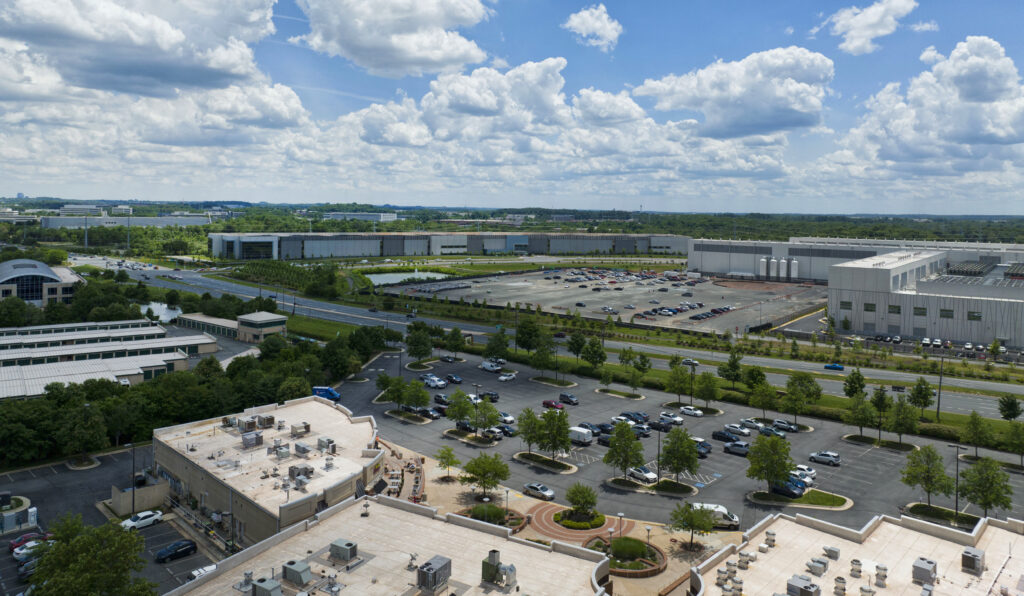Centers of controversy: Is there enough energy for Md. to meet its tech ambitions?

Ashburn, Virginia, lies in the shadow of Dulles International Airport. It’s best known as the home of the Washington Commanders training facilities and corporate offices.
But a drive around the community reveals a curious landscape. Mixed in with the suburban sprawl of townhouses and strip malls are dozens of enormous warehouse buildings, the size of airport hangars or even bigger. Many have no windows.
These are data centers, which house the crucial infrastructure that stores and manages the data that serve the internet. They contain the computing infrastructure that IT systems require, and they hold digital data from myriad sources, including Amazon Web Services and other gargantuan enterprises.
Northern Virginia is home to almost 300 data centers, the highest concentration of these facilities in the world. But Maryland is looking to get in on the action, and the push to make the state a major hub for data centers is a top priority of Gov. Wes Moore (D) and will be part of his legislative package in the upcoming General Assembly session. Speaking at the Maryland Association of Counties winter convention last week, Moore said he plans to make Maryland “the best place for businesses to invest in data center infrastructure that will drive the technology economy.”
State and local leaders and a start-up company already know where they want to start. They are hoping to build a data center campus just across the Potomac River from Ashburn, at a 2,100-acre brownfields site near Buckeystown, which once housed an Alcoa aluminum manufacturing plant that has been shuttered for years.
Officials believe that a data center campus in Frederick County would generate millions of dollars in revenue, create tens of thousands of construction jobs and perhaps 1,500 permanent jobs for people who would work at the facilities. A recent study commissioned by the Maryland Tech Council reached the same conclusions.
The proposal, said Kelly Schulz, the tech council’s CEO, “is a once-in-a-generation chance to revitalize an abandoned industrial site into a modern, environmentally friendly digital campus that powers our regional economy.”
But the data centers also consume an immense amount of energy and usually require proximity to ample supplies of water.
“These data centers have the energy use of medium-sized cities,” said Kumar P. Barve, a member of the Maryland Public Service Commission, which regulates utilities.
As of late 2022, 21% of Dominion Power’s entire electric load in Virginia was being used to power data centers, and an even higher percentage of the portfolio of the Northern Virginia Electric Cooperative was being used for the facilities in and around Ashburn, according to the Virginia Mercury. And that demand is only going to grow.
“The data center industry is almost inevitably going to expand because we’re all using more data,” said Frederick County Executive Jessica Fitzwater (D). “That data has to come from somewhere.”
PJM, the regional electric grid operator, which serves Maryland and 13 other states in the Mid-Atlantic and Midwest, has cautioned that there may not be enough electric transmission capacity to serve the anticipated proliferation of data centers — and has suggested that it could cost upwards of $5 billion to build the transmission capacity to power them, especially with the region’s last remaining coal plants slated to close in the next few years.
In other words, if the data centers come to Frederick County, there could be tremendous consequences for the climate and the environment — and for millions of utility customers throughout the region.
“These data center projects, whether in Northern Virginia or Maryland, have massive implications for Maryland utility customers,” said David Lapp, who heads the Maryland Office of People’s Counsel, a state agency that represents consumer interests on utility matters. “They’re complicated and we’re looking very hard at the totality of the cost and whether the totality is justified and how these costs are allocated.”
‘We decided to try to meet them halfway’
Maryland already has 26 data centers, but most are small and serve a discrete function. The two biggest are operated by federal agencies, Fannie Mae and the Social Security Administration, in Frederick County. But the state attracted the attention of the data industry in 2020, when the General Assembly passed a bill that provided sales and use and personal property tax exemptions for entities that purchased property for data centers.
This put Maryland on par with more than 30 other states, and was basically a no-risk proposition, said the bill’s chief sponsor, state Sen. Stephen S. Hershey Jr. (R-Upper Shore).
“You’re not losing anything” by providing the incentive, he said. “If they weren’t going to build it, you weren’t going to get anything, anyway.”
A year later, a Texas-based startup company called Quantum Loophole, Inc. announced that it had purchased the old Alcoa property in Frederick County to build a large-scale data center campus.
“What we saw was the largest industrial site in Maryland,” said Richard Paul-Hus, vice president of sales and development of Quantum Loophole, who added that the proximity of southern Frederick County to Ashburn was very appealing.
Earlier this year, the company announced the completion of its second of two underwater Potomac River crossings for a network conduit system, a hyperscale fiber ring connecting the Frederick development site to data centers across the river.
But the process of developing the Quantum Loophole site has not been without its setbacks.
During the summer, the company agreed to pause construction on a sewer line at the Frederick campus after the Maryland Department of the Environment (MDE) found permitting lapses and problematic discharges into Tuscarora Creek — though MDE has determined for now that they aren’t harmful to public health.
Paul-Hus said the company is now putting together an environmental management plan for the site in tandem with MDE. “We’re working with them daily on that process,” he said.
Perhaps more troublesome for the development, in late October, a company called Aligned Data Centers, which had purchased 75 acres from Quantum Loophole and planned to build four facilities on the property, pulled out of the project after the Maryland Public Service Commission voted unanimously several weeks earlier to deny the company’s request for a waiver from federal and state environmental rules to install 168 three-megawatt diesel generators as backup power for its planned facilities.
Backup power at data centers, industry experts say, is just as critical as standard power, because it needs to be available for major natural disasters and other emergencies. While the industry is scrambling to find clean energy alternatives, most backup power at data centers across the U.S. is provided by fossil fuel sources.
PSC commissioners did tell Aligned Data that in the spirit of compromise, they would be willing to allow the company to generate 70 megawatts of backup emergency power from diesel engines, enough to launch the first phase of its operation.
“We decided to try to meet them halfway,” Barve said. “They chose not to take this.”
The PSC decision drew a rebuke from Moore after Aligned Data pulled out of the development — even though Moore has appointed three of the five commissioners. And the company in a recent statement warned that the PSC vote “sent a negative — and perhaps fatal — signal to the hoped-for data center industry in Maryland.”
‘We need to develop these centers with appropriate safeguards’
It isn’t yet clear what Moore’s legislation on data centers will contain. Several stakeholders said they believe it will be crafted in a way that gives the PSC more flexibility with environmental standards as a way to give data center companies more options for providing backup power.
A bipartisan group of Virginia politicians was very intentional about wooing the data center industry to their state over 15 years ago, beginning with enacting the tax breaks in 2008 that Maryland adopted a dozen years later. The tech sector already had a significant presence in Northern Virginia, including fiber optic capability, and land there was relatively cheap. The region also had a ready construction workforce and electric utilities with good records of reliability.
Back in Maryland, state Sen. Karen Lewis Young (D-Frederick) and Del. Lily Qi (D-Montgomery) are preparing legislation for the upcoming session that would require Maryland’s data centers to meet certain clean energy goals. The bill will likely call for the facilities to get 60% of their energy from renewable sources by 2027 and 100% by 2040.
“My biggest concerns about data centers — and there are a number of concerns — are their impact on the environment,” Young said. “We need to develop these centers with appropriate safeguards for residents and for the natural environment.”
Young said she sees the legislation as being compatible with the state’s and Frederick County’s goals of attracting data centers. But she concedes that she has already gotten some pushback from the Moore administration. When she went recently to brief officials at the Maryland Department of the Environment about her bill, a high-ranking Moore aide came along.
“It’s fair to say that the individual displayed some concern if not outright displeasure,” Young recounted.
While state policymakers are prepared to debate measures that could impact the data center industry, Frederick County officials are attempting to examine the impact data centers will have on their communities and studying best practices within the industry. Earlier this year, Fitzwater, the county executive, appointed a Data Centers Workgroup with a broad swath of community leaders participating.
The mandate for the workgroup, which began meeting over the summer, includes studying lessons from Northern Virginia’s experience and considering: appropriate locations for data centers; taxation issues; water, power, and other infrastructure needs of data centers; community benefits that can be derived from the industry; and potential changes to county law. The group’s recommendations are expected to result in local legislation to both encourage and regulate the data center industry.
Speaking at the Maryland Association of Counties Conference last week, Fitzwater said she is mindful that the rural area where Quantum Loophole is building is near the most productive farmland in the county, with the richest soil.
“We’re trying to leverage the benefits of the data center industry while preserving Frederick County’s environment and quality of living,” she said.
Already, the county has received assurances from the company that the parcel for the data center campus will remain wooded to the extent possible and largely unseen — a distinct contrast from the way much of Ashburn looks.
“The idea is to create a win-win-win,” Paul-Hus said. “We’re very environmentally thoughtful. We live this in our daily lives. We basically design within nature.”
The county data center workgroup’s meetings have usually focused on distinct topics. At the next session, for example, scheduled for Wednesday evening, a representative of Potomac Edison is scheduled to speak about the project’s impacts on the regional utility’s energy supply.
Originally, the workgroup was supposed to issue a report in January, but that timeline was pushed back until March so the members of the committee could monitor and consider the legislative action in Annapolis. Fitzwater has also put a moratorium on all piecemeal zoning change requests, until the county can devise a comprehensive plan for data centers.
Across the Potomac River, local officials in Prince William County, Va., this month are considering whether to approve a proposed data center campus (Ashburn is in Loudoun County, next door). It has become an increasingly contentious issue.
“It’s not ready for prime time,” a Virginia state legislator who represents the area, Del. Danica Roem (D), said on WAMU Radio’s “Politics Hour” on Friday. “This is four times the size of the Pentagon. It’s a big deal.”
And the Maryland Office of People’s Counsel is continuing to warn that there may not be a sufficient amount of energy available to power these complexes. The board members of PJM, the grid operator, are considering a proposal Monday that would boost transmission capacity across the region. But Lapp, Maryland’s people’s counsel, wrote the PJM directors late Friday urging them to delay their vote, arguing that PJM hasn’t done enough to identify the cost and the financial burden to ratepayers, or taken a sufficient stance to make industrial-scale energy users like data centers pay their fair share.
“The scale, scope, and cost of the [transmission] projects are unprecedented — orders of magnitude larger and in greater complexity compared to all recent PJM managed and directed transmission planning and procurements,” he wrote.





 Creative Commons Attribution
Creative Commons Attribution